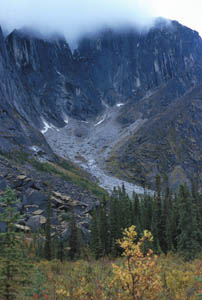The climate of the South Nahanni watershed is primarily cold continental. Because the park is in a mountainous region, weather patterns can fluctuate widely. Visitors should be prepared for extremes in temperatures and conditions.

©Parks Canada / J.W.Borcoman
At the start of the visitor season in June, temperatures may vary from below 0°C to 25°C. July and August are usually the warmest months, with temperatures ranging from 0°C to 30°C. Autumn conditions approach as August advances, and by late August frost may occur during the night. September frequently witnesses freezing temperatures, and ice begins to form on the river in early October. Temperatures generally decrease with elevation, while precipitation tends to increase with elevation.
Summer precipitation is usually convective in nature, occurring in late afternoons or evenings in the form of showers or thundershowers. Precipitation totals in July and August can range from 60 to 90 mm. Severe thunderstorms and periods of intense rain can occur throughout the summer, with peak storm activity in July. Total precipitation from a severe storm event can range from 100 to 150 mm. Heavy thunderstorms may result in flash flooding, especially in narrow confines.
Snowfall can occur anytime, even during the summer months, with amounts of up to 10 cm.
Low cloud cover can impede air access to the park anytime.
- Date modified :